Apps
Auto Added by WPeMatico
Auto Added by WPeMatico
There’s too much hype about mythical “10X developers.” Everyone’s desperate to hire these “ninja rockstars.” In reality, it’s smarter to find ways of deleting annoying chores for the coders you already have. That’s where CTO.ai comes in.
Emerging from stealth today, CTO.ai lets developers build and borrow DevOps shortcuts. These automate long series of steps they usually have to do manually, thanks to integrations with GitHub, AWS, Slack and more. CTO.ai claims it can turn a days-long process like setting up a Kubernetes cluster into a 15-minute task even sales people can handle. The startup offers both a platform for engineering and sharing shortcuts, and a service where it can custom build shortcuts for big customers.
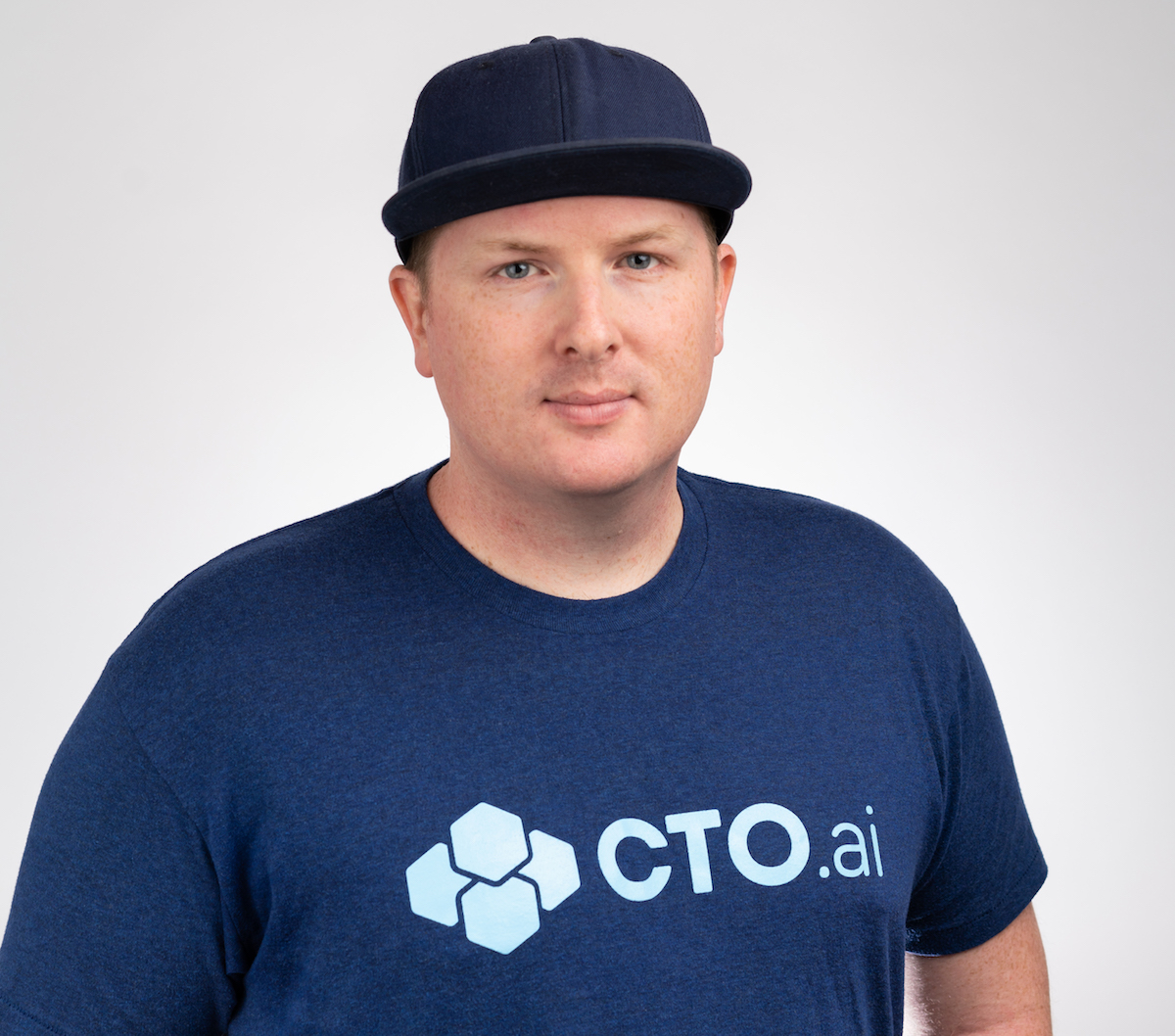
What’s remarkable about CTO.ai is that amidst a frothy funding environment, the 60-person team quietly bootstrapped its way to profitability over the past two years. Why take funding when revenue was up 400% in 18 months? But after a chance meeting aboard a plane connected its high school dropout founder Kyle Campbell with Slack CEO Stewart Butterfield, CTO.ai just raised a $7.5 million seed round led by Slack Fund and Tiger Global.
“Building tools that streamline software development is really expensive for companies, especially when they need their developers focused on building features and shipping to customers,” Campbell tells me. The same way startups don’t build their own cloud infrastructure and just use AWS, or don’t build their own telecom APIs and just use Twilio, he wants CTO.ai to be the “easy button” for developer tools.
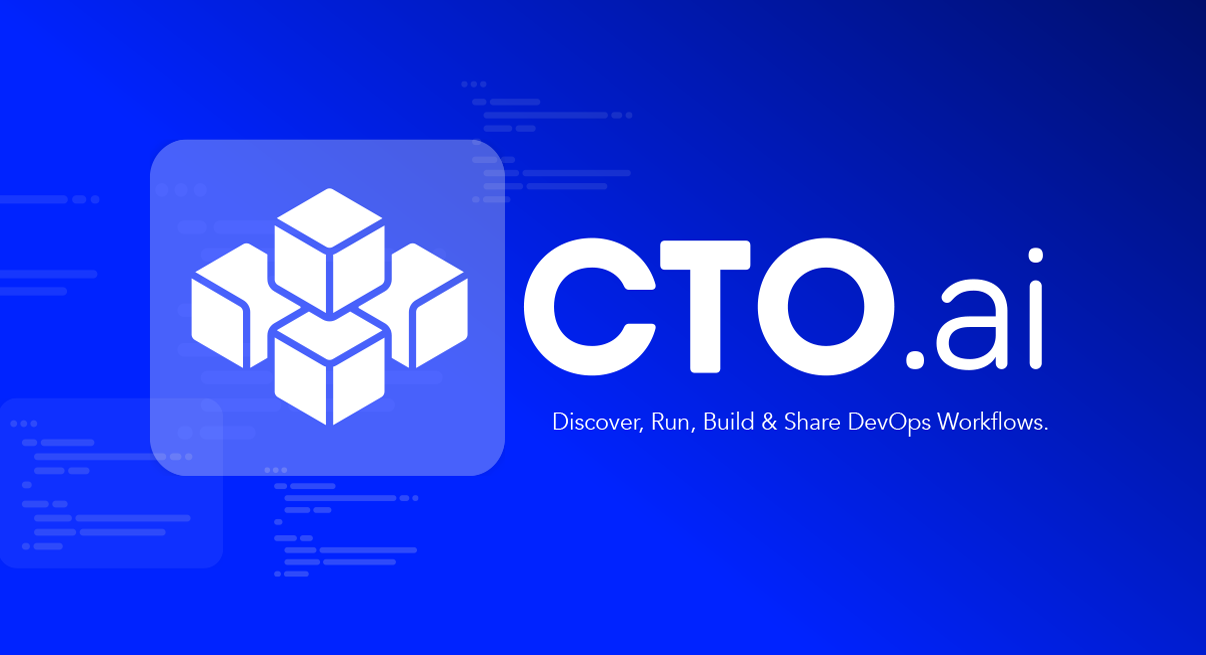
“I’ve been a software engineer since the age of 8,” Campbell recalls. In skate-punk attire with a snapback hat, the young man meeting me in a San Francisco Mission District cafe almost looked too chill to be a prolific coder. But that’s kind of the point. His startup makes being a developer more accessible.
After spending his 20s in software engineering groups in the Bay, Campbell started his own company, Retsly, that bridged developers to real estate listings. In 2014, it was acquired by property tech giant Zillow, where he worked for a few years.
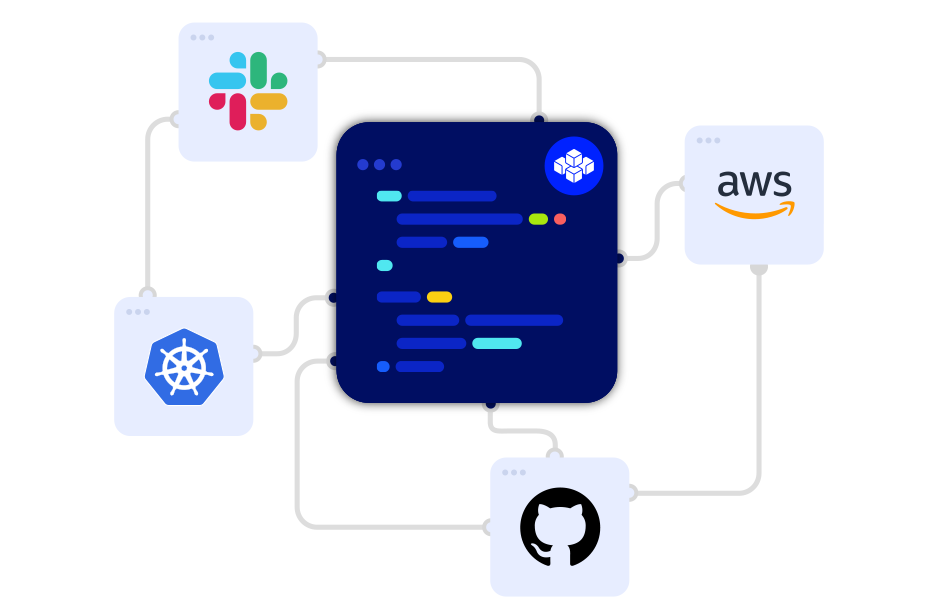
That’s when he discovered the difficulty of building dev tools inside companies with other priorities. “It’s the equivalent of a snake swallowing an elephant,” he jokes. Yet given these tools determine how much time expensive engineers waste on tasks below their skill level, their absence can drag down big enterprises or keep startups from rising.
CTO.ai shrinks the elephant. For example, the busywork of creating a Kubernetes cluster such as having to the create EC2 instances, provision on those instances and then provision a master node gets slimmed down to just running a shortcut. Campbell writes that “tedious tasks like running reports can be reduced from 1,000 steps down to 10,” through standardization of workflows that turn confusing code essays into simple fill-in-the-blank and multiple-choice questions.

The CTO.ai platform offers a wide range of pre-made shortcuts that clients can piggyback on, or they can make and publish their own through a flexible JavaScript environment for the rest of their team or the whole community to use. Companies that need extra help can pay for its DevOps-as-a-Service and reliability offerings to get shortcuts made to solve their biggest problems while keeping everything running smoothly.
Campbell envisions a new way to create a 10X engineer that doesn’t depend on widely mocked advice on how to spot and capture them like trophy animals. Instead, he believes one developer can make five others 2X more efficient by building them shortcuts. And it doesn’t require indulging bad workplace or collaboration habits.
With the new funding that also comes from Yaletown Partners, Pallasite Ventures, Panache Ventures and Jonathan Bixby, CTO.ai wants to build deeper integrations with Slack so developers can run more commands right from the messaging app. The less coding required for use, the broader the set of employees that can use the startup’s tools. CTO.ai may also build a self-service tier to augment its seats, plus a complexity model for enterprise pricing.

Now it’s time to ramp up community outreach to drive adoption. CTO.ai recently released a podcast that saw 15,000 downloads in its first three weeks, and it’s planning some conference appearances. It also sees virality through its shortcut author pages, which, like GitHub profiles, let developers show off their contributions and find their next gig.
One risk is that GitHub or another core developer infrastructure provider could try to barge directly into CTO.ai’s business. Google already has Cloud Composer, while GitHub launched Actions last year. Campbell says its defense comes through neutrally integrating with everyone, thereby turning potential competitors into partners.
The funding firepower could help CTO.ai build a lead. With every company embracing software, employers battling to keep developers happy and teams looking to get more of their staff working with code, the startup sits at the intersection of some lucrative trends of technological empowerment.
“I have a three-year-old at home and I think about what it will be like when he comes into creating things online,” Campbell concludes. “We want to create an amazing future for software developers, introducing automation so they can focus on what makes them such an important aspect. Devs are defining society!”
[Image Credit: Disney/Pixar via WallHere Goodfon]
Powered by WPeMatico
TikTok is looking to expand its influence by integrating with popular third-party video creation and editing apps. The company today announced a new TikTok for Developers program which will introduce tools for third-party app developers, including those that allow them to access TikTok’s creative offerings as well as push content from their apps to TikTok directly. The first of these tools is the new Share to TikTok SDK, which will let users edit videos in other apps then publish them from that app to TikTok.
One of the key launch partners for the new SDK is Adobe Premiere Rush, Adobe’s mobile app for video editing. With the new TikTok integration, Premiere Rush users can access video editing features like aspect ratio switching, transitions, color filters, time lapse and slo-mo, audio control and more, then share instantly to TikTok and other video destinations.
In addition to Adobe, the apps supporting the Share to TikTok SDK at launch also include looping video creator Plotaverse, AR app Fuse.it, gaming highlights recorder Medal, Momento GIF Maker, PicsArt and Enlight Videoleop.

For some of the smaller, single-purpose apps, being able to become a useful tool for the creator community can have an outsized impact on their growth and revenues. For example, Facetune’s maker Lightricks has built a profitable business across its suite of photo and video editing apps, including Enlight Videoleap, and has now raised a total of $205 million.
In addition to built-in sharing features, apps that integrate with the new TikTok SDK will also gain access to a wider selection of creative tools, says TikTok.
But the apps will benefit in another way, too — when creators share their videos, they’ll include the specified partner hashtag along with the content. This will help to give the app the ability to gain exposure among even more TikTok users.
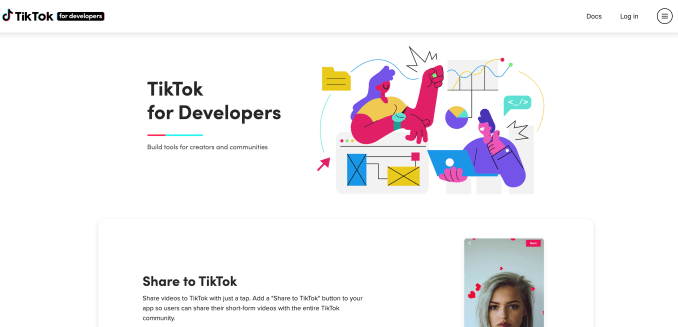
“This new Share to TikTok feature enriches the content available on TikTok, diversifies the types of videos users can discover, and offers more editing choices for users to explore in addition to TikTok’s built-in creative tools,” explained TikTok, in an announcement. “Most importantly, it gives users multiple avenues to create new original, high-quality content using platforms with exciting creative tools,” the company said.
The TikTok for Developers program also includes tools to embed videos on the web, and offers developer documentation, demos and more. The program’s terms of service restricts developers from collecting users’ personal data or other nefarious activity, and threatens developers’ access could be removed if terms are violated.
The news follows reports that the U.S. government has opened a national security review of TikTok owner, Beijing-based ByteDance, specifically with regard to its $1 billion acquisition of U.S. app Musical.ly.
TikTok didn’t say what other plans its has in store for the developers program, only that it will continue to expand access to its own creative tools further across the wider app ecosystem.
Powered by WPeMatico
The mobile version of Nintendo’s iconic racing franchise, Mario Kart Tour, will soon support multiplayer races, bringing the game closer to its competitive roots. A limited multiplayer beta test is planned for December, just in time for holiday laziness, but only for paying subscribers — the rest of us will have to wait.
Mario Kart has had a focus on multiplayer since its first (and best, in my opinion) appearance on the SNES, with multiple modes available pitting players together in real time. So despite Mario Kart Tour’s general excellence as far as gameplay and variety, players have been disappointed by the lack of that core aspect of the game.
Sure, you can post high scores and best times, but that’s nothing compared with the feeling of coming from behind in a hard-fought race and beating out half a dozen tough competitors.

Well, players will soon have that opportunity — if they happen to be Gold Pass subscribers. That’s the subscription tier that gives access to extra content in the “free to start” game, and will be a requirement to join the beta.
Naturally this will provoke ire among players who feel they are owed not just a free game, but a free game that gives them everything they want for free. And in fact they may eventually get that, but it’s probably smart for Nintendo to limit this experience at first to paying customers so they can stress-test, balance gameplay and so on. A subpar multiplayer experience is a good way to turn off otherwise interested players.
Still, this feeds into a larger dissatisfaction among gamers with Nintendo’s online and multiplayer strategy. The subscription service required for many popular games on the Switch comes with a selection of Nintendo and Super Nintendo Games, but beyond that the benefits are minimal, and features standard on other platforms for years — voice chat, for instance — are absent or long in coming.
At only $20 a year it’s hardly a big investment, but subscription fatigue is growing among tech-savvy consumers and they are cutting things out where they can. Hopefully Nintendo’s offering will solidify and survive.
Powered by WPeMatico
We’ve known for a while now that Google was bringing the “Incognito mode” concept to Maps, allowing you to run searches and find routes without them automatically being tied to your account history.
If you’ve been digging around trying to find the option without any luck, you weren’t just missing it. Though first mentioned back in May at Google I/O, the company says the rollout is just now officially underway.
Word of the rollout comes via a Google Maps support page, as first spotted by AndroidPolice.
It’s a staged rollout, so don’t be surprised if you don’t see the new feature immediately, even if you’re on the latest version of maps. It’s rolling out in batches, beginning with Android users. Google says it should be available to all Android users in “the next few days.”
Once it’s enabled on your account, you can toggle incognito mode on/off by tapping your profile picture, then flipping the switch. Here’s what that looks like:
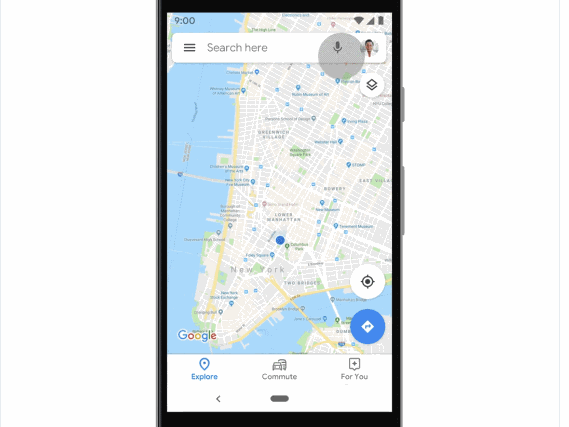
So why incognito mode? As we wrote back in May: Whether it’s the holiday season and you’re trying to keep your gift-hunting locations under wraps, or you’re visiting a doctor and would just prefer it not pop up the next time a friend grabs your phone for some quick directions, there are all sorts of reasons you might want to leave fewer breadcrumbs. Remember, though, that while it’s less visibly tied to you, it’s still all stored in ways behind the scenes on Google’s end; the company told Wired earlier this month that while Incognito sessions aren’t tied to an account, they are logged with a unique session identifier that gets reset between sessions.
Powered by WPeMatico
Despite ongoing public relations crises, Facebook kept growing in Q3 2019, demonstrating that media backlash does not necessarily equate to poor business performance.
Facebook reached 2.45 billion monthly users, up 1.65%, from 2.41 billion in Q2 2019 when it grew 1.6%, and it now has 1.62 billion daily active users, up 2% from 1.587 billion last quarter when it grew 1.6%. Facebook scored $17.652 billion of revenue, up 29% year-over-year, with $2.12 in earnings per share.
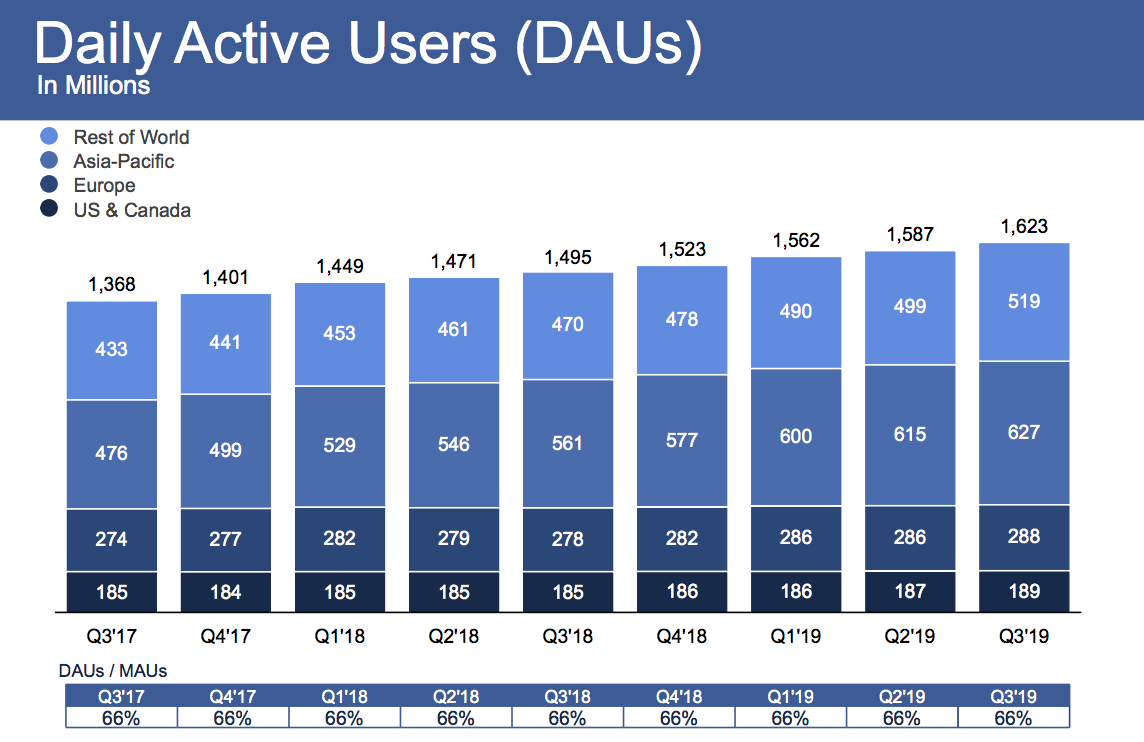
Facebook’s earnings beat expectations compared to Refinitiv’s consensus estimates of $17.37 billion in revenue and $1.91 earnings per share. Facebook’s quarter was mixed compared to Bloomberg’s consensus estimate of $2.28 EPS. Facebook earned $6 billion in profit after only racking up $2.6 billion last quarter due to its SEC settlement.
Facebook shares rose 5.18% in after-hours trading, to $198.01 after earnings were announced, following a day where it closed down 0.56% at $188.25.
Notably, Facebook gained 2 million users in each of its core U.S. & Canada and Europe markets that drive its business, after quarters of shrinkage, no growth or weak growth there in the past two years. Average revenue per user grew healthily across all markets, boding well for Facebook’s ability to monetize the developing world where the bulk of user growth currently comes from.
Facebook says 2.2 billion users access Facebook, Instagram, WhatsApp or Messenger every day, and 2.8 billion use one of this family of apps each month. That’s up from 2.1 billion and 2.7 billion last quarter. Facebook has managed to stay sticky even as it faces increased competition from a revived Snapchat, and more recently TikTok. However, those rivals might more heavily weigh on Instagram, for which Facebook doesn’t routinely disclose user stats.
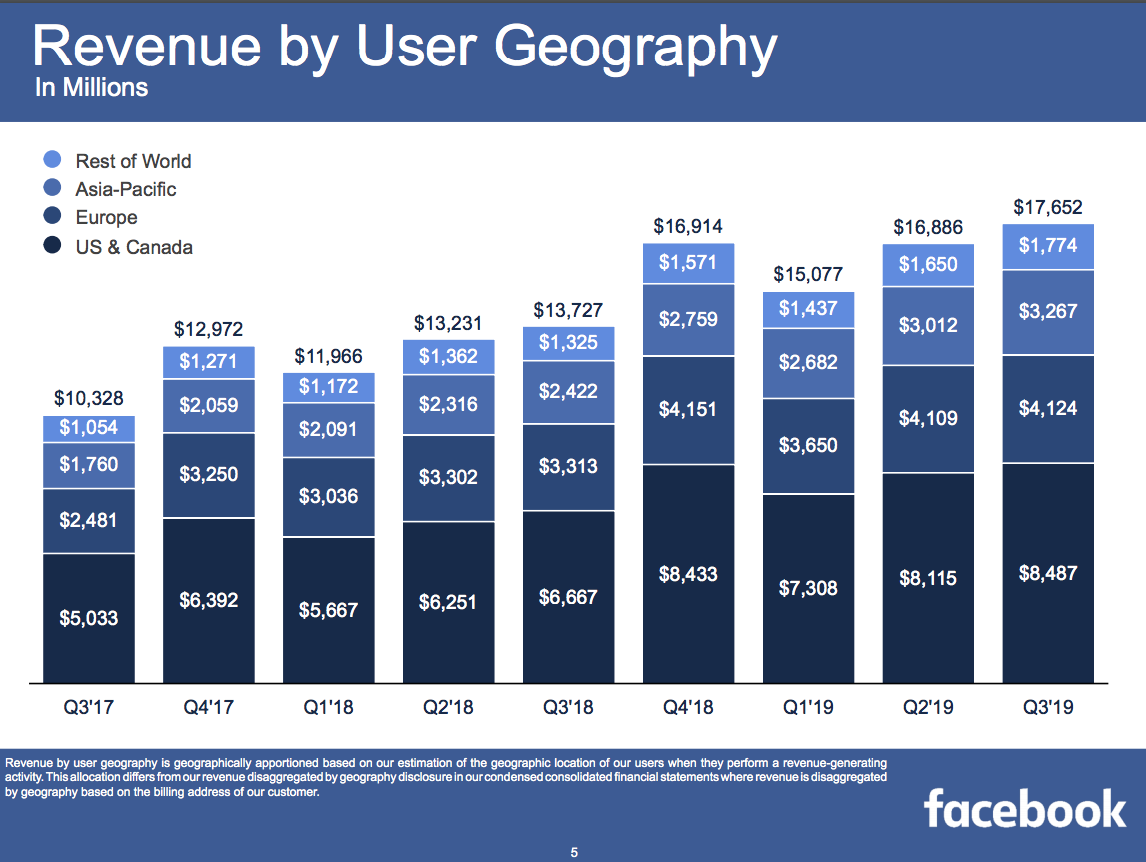
Facebook’s earnings announcement was somewhat overshadowed by Twitter CEO Jack Dorsey announcing it would ban all political ads — something TechCrunch previously recommended social networks do. That move flies in the face of Facebook CEO Mark Zuckerberg’s staunch support for allowing politicians to spread misinformation without fact-checks via Facebook ads. This should put additional pressure on Facebook to rethink its policy.
Zuckerberg doubled-down on the policy, saying “I believe that the better approach is to work to increase transparency. Ads on Facebook are already more transparent than anywhere else,” he said. Attempting to dispel that the policy is driven by greed, he noted Facebook expects political ads to make up “less than 0.5% of our revenue next year.” Because people will disagree and the issue will keep coming up, Zuckerberg admitted it’s going to be “a very tough year.”
Facebook also announced that lead independent board member Susan D. Desmond-Hellmann has resigned to focus on health issues.
Facebook expects revenue deceleration to be pronounced in Q4. But CFO David Wehner provided some hope, saying “we would expect our revenue growth deceleration in 2020 versus the Q4 rate to be much less pronounced.” That led Facebook’s share price to spike from around $191 to around $198.
However, Facebook will maintain its aggressive hiring to moderate content. While the company has touted how artificial intelligence would increasingly help, Zuckerberg said that hiring would continue because “There’s just so much content. We do need a lot of people.”
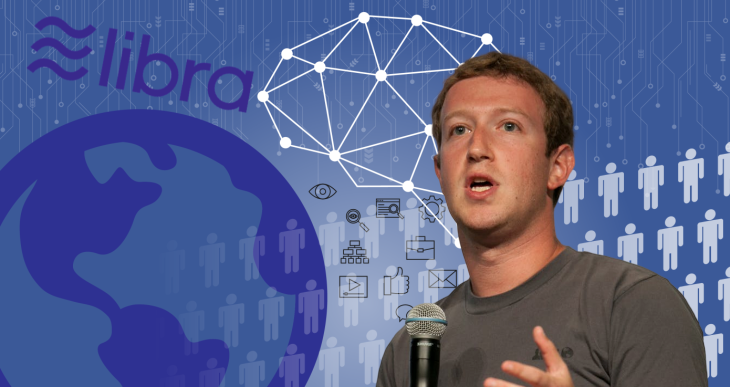
Regarding Libra’s regulatory pushback, Zuckerberg explained that Facebook was already diversified in commerce if that doesn’t work out, citing WhatsApp Payments, Facebook Marketplace and Instagram shopping.
On anti-trust concerns, Zuckerberg reminded analysts that Instagram’s success wasn’t assured when Facebook acquired it, and it has survived a lot of competition thanks to Facebook’s contributions. In a new talking point we’re likely to hear more of, Zuckerberg noted that other competitors had used their success in one vertical to push others, saying “Apple and Google built cameras and private photo sharing and photo management directly into their operating systems.”
Overall, it was another rough quarter for Facebook’s public perception as it dealt with outages and struggled to get buy-in from regulators for its Libra cryptocurrency project. Former co-founder Chris Hughes (who I’ll be leading a talk with at SXSW) campaigned for the social network to be broken up — a position echoed by Elizabeth Warren and other presidential candidates.
The company did spin up some new revenue sources, including taking a 30% cut of fan patronage subscriptions to content creators. It’s also trying to sell video subscriptions for publishers, and it upped the price of its Workplace collaboration suite. But gains were likely offset as the company continued to rapidly hire to address abusive content on its platform, which saw headcount grow 28% year-over-year, to 43,000. There are still problems with how it treats content moderators, and Facebook has had to repeatedly remove coordinated misinformation campaigns from abroad. Appearing concerned about its waning brand, Facebook moved to add “from Facebook” to the names of Instagram and WhatsApp.
It escaped with just a $5 billion fine as part of its FTC settlement that some consider a slap on the wrist, especially since it won’t have to significantly alter its business model. But the company will have to continue to invest and divert product resources to meet its new privacy, security and transparency requirements. These could slow its response to a growing threat: Chinese tech giant ByteDance’s TikTok.
Powered by WPeMatico
In a move to boost family subscriptions to its app, Spotify this morning announced the launch of a dedicated Kids application which allows children three and up to listen to their own music, both online and offline, as well as explore playlists and recommendations picked by experts, and more. The music selection is also filtered so songs won’t have explicit content.
The launch is a first in the online music streaming space, where kids on parents’ music plans typically sign in through the same app — just with a different login. But Spotify believes children deserve their own space, where the music they listen to is available in an ad-free environment, where they won’t accidentally encounter lyrics that parents disapprove of, and where content is hand-curated by editors.
Spotify Kids, essentially, is a set of hand-picked playlists across categories.
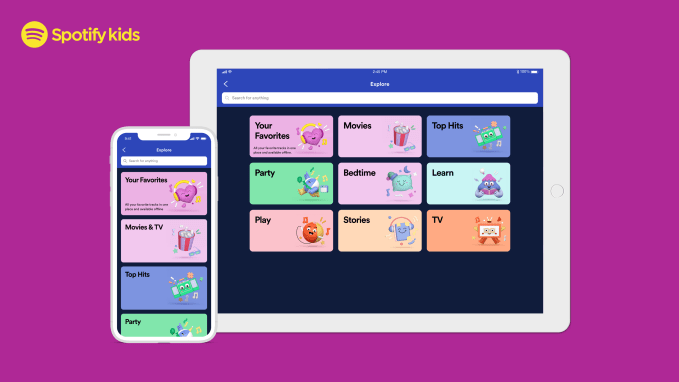
The app includes categories like Movies & TV, top hits, Activities (bedtime, homework, playtime, etc.), genres, seasonal, Spotify Originals, artist/groups, and Stories.
The playlists are all programmed by human editors, not algorithms, and are chosen by way of a set of guidelines about what’s appropriate for children.
The editors, Spotify says, have backgrounds from some of the most well-known brands in the children’s entertainment business, including Nickelodeon, Disney, Discovery Kids, Universal Pictures, Public Service (Sweden), and BookBeat (a family and kids-oriented audio streaming service).
The new app isn’t just for the preschool set. Instead, it can grow with the kids as they get older — but still aren’t ready for the parents’ application yet.
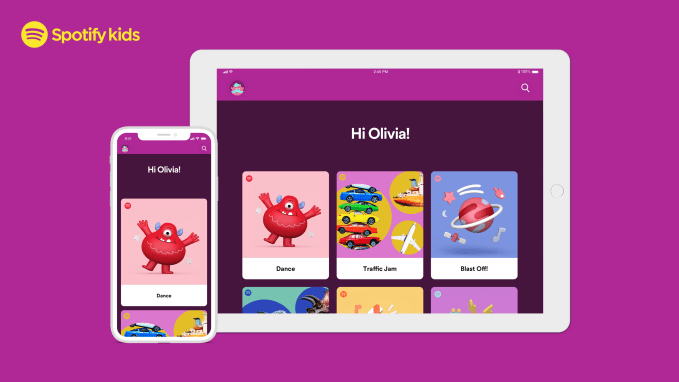
In the younger kids’ version, children can listen to things like singalongs, lullabies, and soundtracks aimed at little kids. Older users have access to tracks and playlists of their own, including some popular tracks, that are appropriate and relevant for their age group. Parents will select their child’s age group upon launch.
In time, Spotify will expand the app with more content — including stories, audiobooks, and podcasts — and build enhanced parental settings and controls that allow parents to customize the Kids app further.
The new app also looks nothing like the main app — it’s colorful and bright, and has a look and feel that varies by the kids’ age group. For example, the younger kids see artwork that’s softer and character-based, while older kids have a more detailed experience.

“Spotify is committed to giving billions of fans the opportunity to enjoy and be inspired by music and stories and we’re proud that this commitment now includes the next generation of audio listeners,” said Spotify’s Chief Premium Business Officer Alex Norström. “We are excited to be expanding the Spotify Premium Family experience with a dedicated app just for our youngest fans. Spotify Kids is a personalized world bursting with sound, shape and color, where our young listeners can begin a lifelong love of music and stories.”
The launch of the Kids app follows Spotify’s surprise earnings success this week, where it beat Wall St. estimates with net income of 241 million euros ($267.34 million), or 36 cents per share. Analysts had expected a loss of 29 cents per share.
The company also added 5 million new subscribers in the quarter to reach 113 million paying premium subscribers — up 26 million from the year-ago quarter.
Today, a Spotify Premium plan costs slightly more than a regular Premium account ($14.99 vs. $9.99 in the U.S., respectively). But many parents often just share their account with the whole family — often ruining their recommendations and special features, like Spotify Wrapped, along the way. A Kids app is a good incentive to convince customers to upgrade, as it’s not only solving those problems but also giving kids a safer, more curated experience within the larger music ecosystem.
There’s another incentive for Spotify to separate out Kids’ listening into its own space: targeted advertising. While the Premium experience has typically been ad-free, a new product lets artists buy a full-screen ad about their new music release and show it to interested users, based on listening history — even if they’re Premium subscribers.
This isn’t the first move Spotify has made in recent months to better cater to families. The company this summer launched a dedicated streaming hub in partnership with Disney, where families could find favorite songs, playlists and soundtracks. It also added parental controls to Premium Family accounts soon after, and launched a special “family mix” with songs everyone can agree on.
Spotify Kids is initially available in beta, while Spotify works to refine the experience based on additional insights gained from use as well as parents‘ feedback. It requires a Premium Family plan to use.
The app is immediately available today in Ireland on iOS and Android, but is rolling out to all markets, the company says.
Powered by WPeMatico
MX Player, a popular video app that offers both local playback and streaming services, said on Wednesday that it has raised $110.8 million in a new financing round led by Chinese internet giant Tencent as the video app looks to expand its business in India and other international markets.
Times Internet, which acquired a majority stake in MX Player in late 2017 for $140 million, also participated in the Series A financing round. The post-money valuation of MX Player was $500 million, a person familiar with the matter told TechCrunch.
The addition of Tencent — which has invested in a handful of Indian startups including Times Internet-owned Gaana, ride-hailing giant Ola, ed tech startup Byju’s, B2B e-commerce startup Udaan and a bookkeeping service for merchants, Khatabook — “is a great sign of confidence,” said Satyan Gajwani, vice chairman of Times Internet. “Tencent is a leading global force in music and video, and there’s a lot for us to learn and leverage from their capabilities,” he added.
Karan Bedi, CEO of MX Player, said in an interview that the video app will use the fresh capital to double down on producing original TV shows and broadening its catalog of licensed content. The firm, which has so far added 15 original shows to its platform, has already commissioned production of another 20 by year-end, he said.
The Singapore-headquartered firm’s push into original shows and licensed content underscores one of the strangest evolution for a video app. MX Player originated in Korea as an app that could run video files in a wide-range of formats locally stored on a phone.
The app did all of this while consuming little resources, an ability that helped it win tens of millions of users with low-cost Android smartphones in emerging markets such as India. In fact, India is MX Player’s largest market, with 175 million monthly active users, Bedi said. Globally, the app has amassed more than 280 million users.
MX Player is ad-supported and does not charge users any monthly subscription fee. The service, which introduced movies and shows streaming in mid-2018, today also offers access to about 200 TV channels, their current and back catalog of shows, and a music streaming feature through an integration with Gaana.
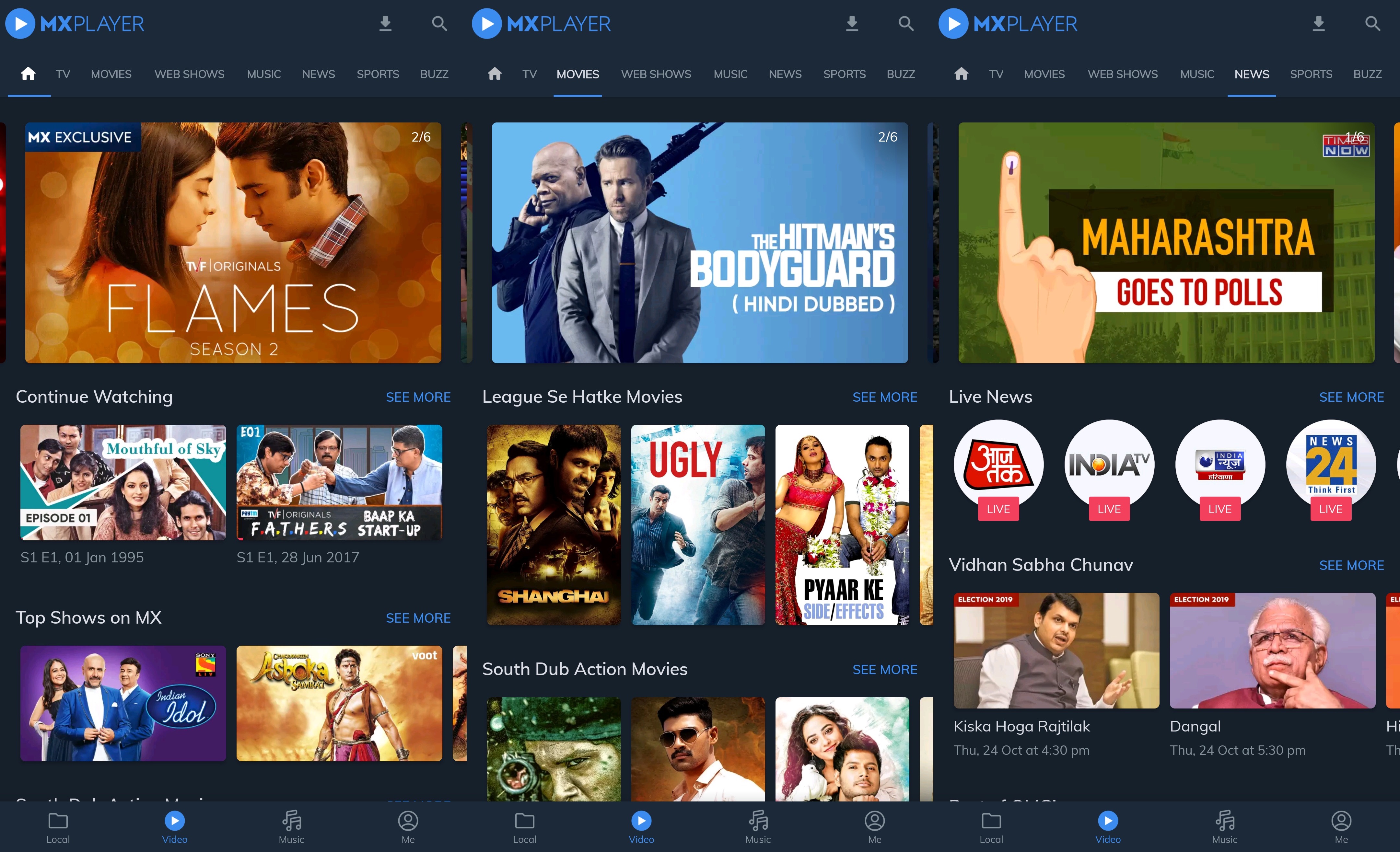
Bedi said the company has tied up with all-web show producers such as HoiChoi in India and three of the top five TV local cable networks, including Sony and Sun. Missing from the list is Star India, the largest TV network in the country.
Thanks to the acquisition of 21st Century Fox, Disney now owns Star India. Star India has emerged as one of the gems in Disney’s new portfolio. The firm, which runs dozens of TV channels in India, operates Hotstar, the market-leading video streaming service.
Hotstar reported 300 million monthly active users and 100 million daily active users during the ICC Cricket World Cup tournament. The service has cashed in on the popularity of cricket to boost its numbers.
Bedi said MX Player is working on building new entertainment experiences, but sports content is not something it is exploring. The reason is simple: Cricket drives most of the sports streaming in India and Star India has secured rights to most of such content. (Facebook recently grabbed a slice of it, too.)
But cricket alone can’t help a streaming service win and sustain customers. Even Hotstar’s monthly user base plummets below 60 million in the months following the cricketing season, people familiar with Hotstar’s internal figures have told TechCrunch.
Figuring out what exactly resonates with the users in India, the world’s second largest internet market, is the billion-dollar question. The video streaming market in India is on track to be worth $1.7 billion in the next four years, according to PricewaterhouseCoopers.
Bedi, who spearheaded Eros Now’s India business before joining MX Player, said users are increasingly enjoying the original shows. Most of the shows that MX Player has produced so far, such as “Hey Prabhu,” “Thinkistan” and “Immature,” are largely targeted at college students and those who have just joined the work force. But the company is slowly populating the platform with shows such as “Queen” that appeal “universally,” he said.

MX Player today competes with more than three dozen local and international players, nearly all of which offer their services at dirt-cheap prices in India. Even Netflix, which launched in India with a $8 plan in 2016, this year introduced a $2.8 monthly tier. In recent months, several more firms including e-commerce giant Flipkart and food delivery startup Zomato have launched their video streaming services in the country.
Tencent-rival Alibaba announced earlier this year that it would invest $100 million to expand social video app Vmate in India.
Once cautious about each megabyte they spent consuming internet services, Indians are now spending about 10GB of data on their smartphones each month as data prices crash in the country, according to an Ericsson report. Indian billionaire Mukesh Ambani disrupted the local telecom market in 2016 when he launched Reliance Jio. The 4G-only carrier undercut the market by first offering bulk of mobile data at no cost, and then charging very little fee.
An analyst TechCrunch spoke with said it’s only a matter of time before India’s video market begins to see some consolidation and pull back. “You have to offer something appealing that none of your rivals have,” he said, requesting anonymity as he advises many of these businesses.
For MX Player, its odd evolution story may be its biggest advantage. The app’s local video playback feature continues to draw many to it, and keeps the app among the top rated in Google’s Play Store. Bedi said the startup, which today employs about 300 people, maintains a large team that continues to improve the tech stacks to improve video playback support.
Moving forward, MX Player will also look into expanding to some international markets. It recently started beta testing the video streaming service in the U.S., Canada, Australia and New Zealand. Eventually, the startup hopes to make original shows for these markets that are relevant to the local audience there.
MX Player maintains a premium app on Google Play Store that strips ads for $5. But the app continues to mostly rely on revenue it generates from ads. Times Internet’s Gajwani said that at some point in the future, the video service will expand monetization beyond pure advertising. “That said, MX is consumed daily as much as the leading TV channel in India, so there’s significant headroom to capture larger advertising spends as well,” he added.
Paytm, a leading financial services firm in India, was also in talks with MX Player to invest in this financial round. It may invest in the video streaming services app at a later stage, a person familiar with the talks said.
Powered by WPeMatico
Submit campaign ads to fact checking, limit microtargeting, cap spending, observe silence periods or at least warn users. These are the solutions Facebook employees put forward in an open letter pleading with CEO Mark Zuckerberg and company leadership to address misinformation in political ads.
The letter, obtained by The New York Times’ Mike Isaac, insists that “Free speech and paid speech are not the same thing . . . Our current policies on fact checking people in political office, or those running for office, are a threat to what FB stands for.” The letter was posted to Facebook’s internal collaboration forum a few weeks ago.
The sentiments echo what I called for in a TechCrunch opinion piece on October 13th calling on Facebook to ban political ads. Unfettered misinformation in political ads on Facebook lets politicians and their supporters spread inflammatory and inaccurate claims about their views and their rivals while racking up donations to buy more of these ads.
The social network can still offer freedom of expression to political campaigns on their own Facebook Pages while limiting the ability of the richest and most dishonest to pay to make their lies the loudest. We suggested that if Facebook won’t drop political ads, they should be fact checked and/or use an array of generic “vote for me” or “donate here” ad units that don’t allow accusations. We also criticized how microtargeting of communities vulnerable to misinformation and instant donation links make Facebook ads more dangerous than equivalent TV or radio spots.
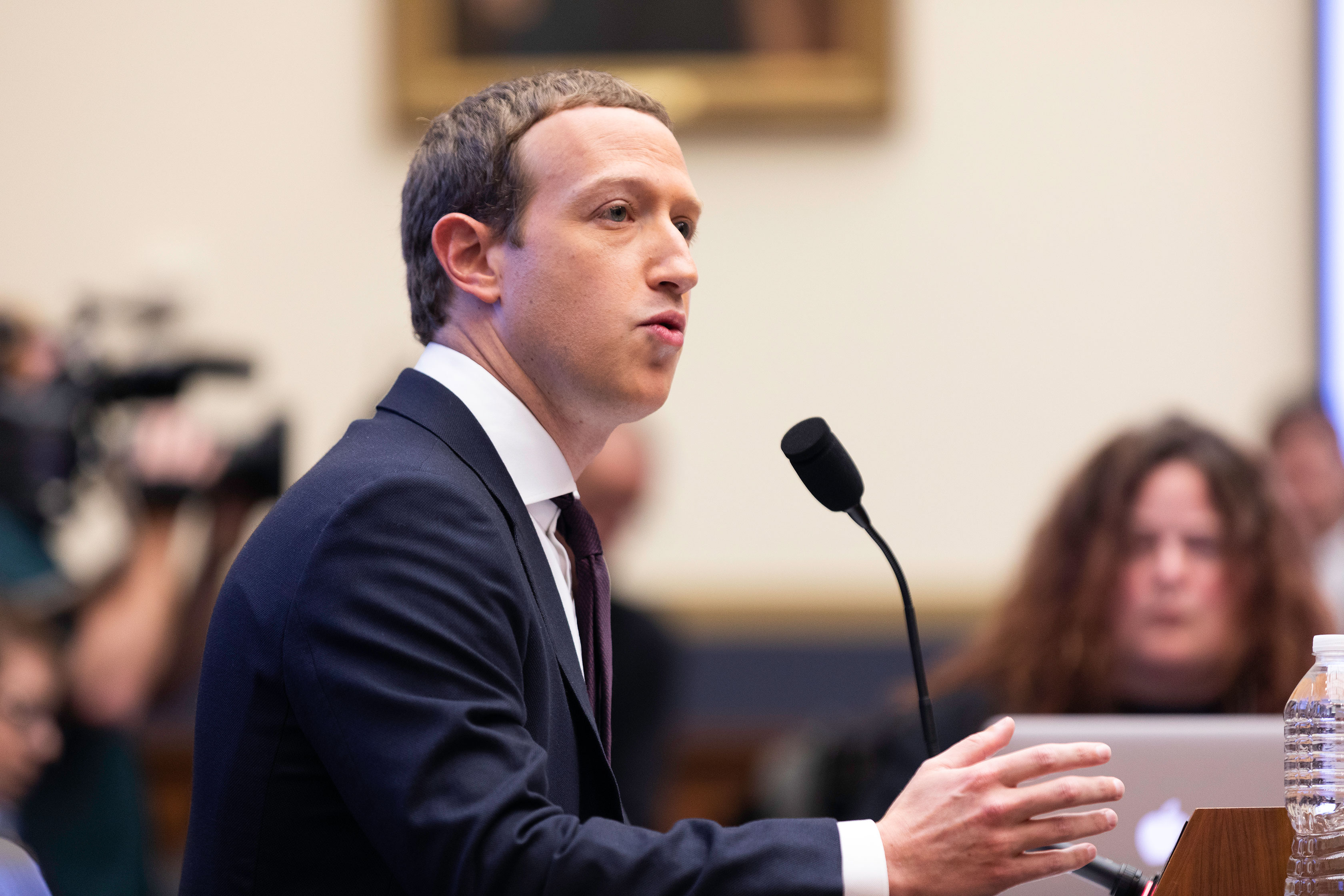
The Facebook CEO, Mark Zuckerberg, testified before the House Financial Services Committee on Wednesday October 23, 2019 in Washington, D.C. (Photo by Aurora Samperio/NurPhoto via Getty Images)
More than 250 employees of Facebook’s 35,000 staffers have signed the letter, which declares, “We strongly object to this policy as it stands. It doesn’t protect voices, but instead allows politicians to weaponize our platform by targeting people who believe that content posted by political figures is trustworthy.” It suggests the current policy undermines Facebook’s election integrity work, confuses users about where misinformation is allowed, and signals Facebook is happy to profit from lies.
The solutions suggested include:
A combination of these approaches could let Facebook stop short of banning political ads without allowing rampant misinformation or having to police individual claims.
Facebook’s response to the letter was “We remain committed to not censoring political speech, and will continue exploring additional steps we can take to bring increased transparency to political ads.” But that straw-man’s the letter’s request. Employees aren’t asking politicians to be kicked off Facebook or have their posts/ads deleted. They’re asking for warning labels and limits on paid reach. That’s not censorship.
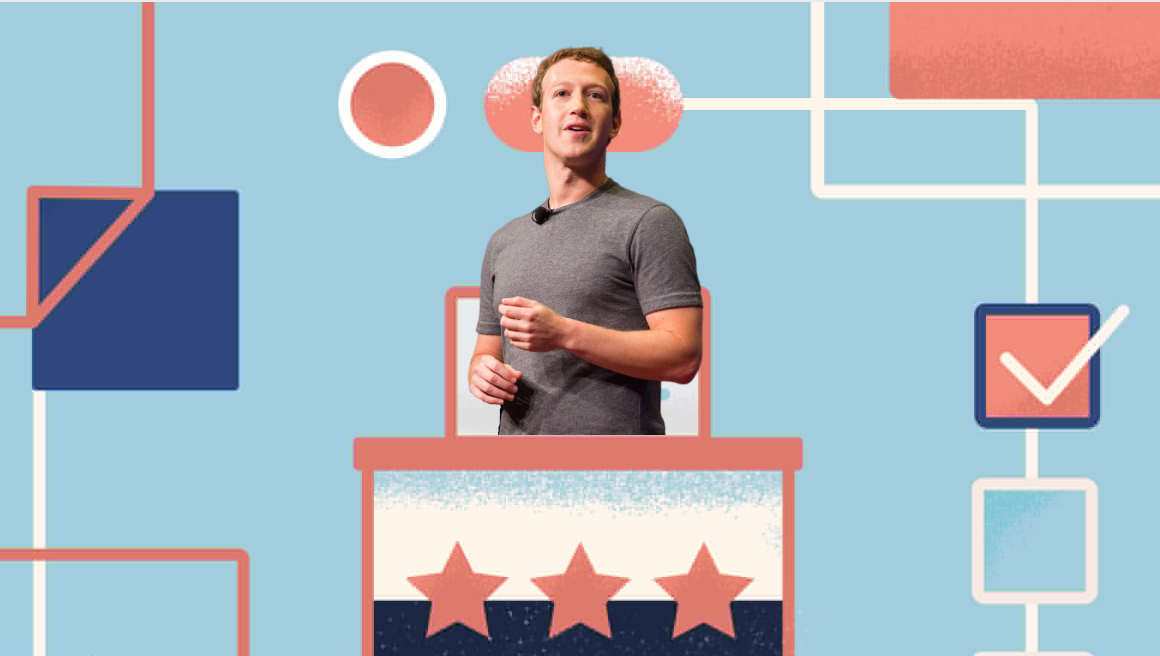
Zuckerberg had stood resolute on the policy despite backlash from the press and lawmakers, including Representative Alexandria Ocasio-Cortez (D-NY). She left him tongue-tied during a congressional testimony when she asked exactly what kinds of misinfo were allowed in ads.
But then Friday, Facebook blocked an ad designed to test its limits by claiming Republican Lindsey Graham had voted for Ocasio-Cortez’s Green Deal he actually opposes. Facebook told Reuters it will fact-check PAC ads.
One sensible approach for politicians’ ads would be for Facebook to ramp up fact-checking, starting with presidential candidates until it has the resources to scan more. Those fact-checked as false should receive an interstitial warning blocking their content rather than just a “false” label. That could be paired with giving political ads a bigger disclaimer without making them too prominent-looking in general and only allowing targeting by state.
Deciding on potential spending limits and silent periods would be more messy. Low limits could even the playing field and broad silent periods, especially during voting periods, and could prevent voter suppression. Perhaps these specifics should be left to Facebook’s upcoming independent Oversight Board that acts as a supreme court for moderation decisions and policies.

Zuckerberg’s core argument for the policy is that over time, history bends toward more speech, not censorship. But that succumbs to utopic fallacy that assumes technology evenly advantages the honest and dishonest. In reality, sensational misinformation spreads much further and faster than level-headed truth. Microtargeted ads with thousands of variants undercut and overwhelm the democratic apparatus designed to punish liars, while partisan news outlets counter attempts to call them out.
Zuckerberg wants to avoid Facebook becoming the truth police. But as we and employees have put forward, there is a progressive approach to limiting misinformation if he’s willing to step back from his philosophical orthodoxy.
The full text of the letter from Facebook employees to leadership about political ads can be found below, via The New York Times:
We are proud to work here.
Facebook stands for people expressing their voice. Creating a place where we can debate, share different opinions, and express our views is what makes our app and technologies meaningful for people all over the world.
We are proud to work for a place that enables that expression, and we believe it is imperative to evolve as societies change. As Chris Cox said, “We know the effects of social media are not neutral, and its history has not yet been written.”
This is our company.
We’re reaching out to you, the leaders of this company, because we’re worried we’re on track to undo the great strides our product teams have made in integrity over the last two years. We work here because we care, because we know that even our smallest choices impact communities at an astounding scale. We want to raise our concerns before it’s too late.
Free speech and paid speech are not the same thing.
Misinformation affects us all. Our current policies on fact checking people in political office, or those running for office, are a threat to what FB stands for. We strongly object to this policy as it stands. It doesn’t protect voices, but instead allows politicians to weaponize our platform by targeting people who believe that content posted by political figures is trustworthy.
Allowing paid civic misinformation to run on the platform in its current state has the potential to:
— Increase distrust in our platform by allowing similar paid and organic content to sit side-by-side — some with third-party fact-checking and some without. Additionally, it communicates that we are OK profiting from deliberate misinformation campaigns by those in or seeking positions of power.
— Undo integrity product work. Currently, integrity teams are working hard to give users more context on the content they see, demote violating content, and more. For the Election 2020 Lockdown, these teams made hard choices on what to support and what not to support, and this policy will undo much of that work by undermining trust in the platform. And after the 2020 Lockdown, this policy has the potential to continue to cause harm in coming elections around the world.
Proposals for improvement
Our goal is to bring awareness to our leadership that a large part of the employee body does not agree with this policy. We want to work with our leadership to develop better solutions that both protect our business and the people who use our products. We know this work is nuanced, but there are many things we can do short of eliminating political ads altogether.
These suggestions are all focused on ad-related content, not organic.
1. Hold political ads to the same standard as other ads.
a. Misinformation shared by political advertisers has an outsized detrimental impact on our community. We should not accept money for political ads without applying the standards that our other ads have to follow.
2. Stronger visual design treatment for political ads.
a. People have trouble distinguishing political ads from organic posts. We should apply a stronger design treatment to political ads that makes it easier for people to establish context.
3. Restrict targeting for political ads.
a. Currently, politicians and political campaigns can use our advanced targeting tools, such as Custom Audiences. It is common for political advertisers to upload voter rolls (which are publicly available in order to reach voters) and then use behavioral tracking tools (such as the FB pixel) and ad engagement to refine ads further. The risk with allowing this is that it’s hard for people in the electorate to participate in the “public scrutiny” that we’re saying comes along with political speech. These ads are often so micro-targeted that the conversations on our platforms are much more siloed than on other platforms. Currently we restrict targeting for housing and education and credit verticals due to a history of discrimination. We should extend similar restrictions to political advertising.
4. Broader observance of the election silence periods
a. Observe election silence in compliance with local laws and regulations. Explore a self-imposed election silence for all elections around the world to act in good faith and as good citizens.
5. Spend caps for individual politicians, regardless of source
a. FB has stated that one of the benefits of running political ads is to help more voices get heard. However, high-profile politicians can out-spend new voices and drown out the competition. To solve for this, if you have a PAC and a politician both running ads, there would be a limit that would apply to both together, rather than to each advertiser individually.
6. Clearer policies for political ads
a. If FB does not change the policies for political ads, we need to update the way they are displayed. For consumers and advertisers, it’s not immediately clear that political ads are exempt from the fact-checking that other ads go through. It should be easily understood by anyone that our advertising policies about misinformation don’t apply to original political content or ads, especially since political misinformation is more destructive than other types of misinformation.
Therefore, the section of the policies should be moved from “prohibited content” (which is not allowed at all) to “restricted content” (which is allowed with restrictions).
We want to have this conversation in an open dialog because we want to see actual change.
We are proud of the work that the integrity teams have done, and we don’t want to see that undermined by policy. Over the coming months, we’ll continue this conversation, and we look forward to working towards solutions together.
This is still our company.
Powered by WPeMatico
Apple has released iOS 13.2 and iPadOS 13.2 for the iPhone and iPad. This update features the usual bug fixes and security improvements. But Apple is also adding a handful of new features to its operating system.
First, iOS 13.2 brings a ton of new emojis. The company now officially supports Unicode 12.0. You can now create all possible combinations of handholding-couple emojis regardless of gender or skin tone. There are new accessibility-focused emojis, such as a service dog, people using wheelchairs, prosthetic arms and legs, a person with a white cane and more. There also are new animals, a yawning face and new food options.
If you have an iPhone 11 or iPhone 11 Pro, iOS 13.2 enables Deep Fusion, an image-processing feature that should make your photos look better thanks to machine learning-enabled processing.
It’s also worth mentioning that you can now change the resolution and frame rate of your videos in the Camera app directly.
With iOS 13.2, you can opt out of sharing Siri recordings with Apple employees and delete your Siri and dictation history. Go to Settings > Privacy > Analytics and Improvements to opt out at any time.
Finally, iOS 13.2 enables HomeKit Secure Video for HomeKit-enabled cameras and adds support for the newly announced AirPods Pro.
Before updating to iOS 13.2, back up your device. Make sure your iCloud backup is up to date by opening the Settings app on your iPhone or iPad and tapping on your account information at the top and then on your device name. Additionally, you can plug your iOS device into your computer to do a manual backup in iTunes.
Don’t forget to encrypt your backup in iTunes. It is much safer if somebody hacks your computer. And encrypted backups include saved passwords and health data. This way, you don’t have to reconnect to all your online accounts.
Once this is done, you should go to Settings as soon as possible to get in the queue. Navigate to ‘Settings,’ then ‘General’ and then ‘Software Update.’ Then you should see ‘Update Requested…’ It will then automatically start downloading once the download is available.
Powered by WPeMatico
Apple Arcade introduced the idea of all-you-can-eat subscription-based mobile gaming to the mainstream. Google Play Pass soon followed as a way to subscribe to a sizable collection of both apps and games on Android devices. Today, a startup called GameClub is launching in the U.S. to offer an alternative. For $4.99 per month, mobile consumers will be able to access a library that includes some of the best games to have ever hit the App Store.
To be clear, GameClub is not a cloud gaming platform, like Google Stadia. It’s a way to subscribe to actual App Store games, similar to Arcade. In GameClub’s case, however, the focus is not on new releases but on quality games that already have proven track records and high ratings.
In fact, many GameClub games have made Apple’s own editorially selected “Game of the Year” lists in years past. And like the games offered on Apple Arcade, they don’t have ads or any in-app purchases.

At launch, GameClub’s library includes more than 100 titles, with around half that available for play today. More titles will roll out on a weekly basis in the months ahead. Combined, the games have over 100 million collective downloads, the company says.
On GameClub, you’ll find games like: Super Crate Box, Hook Champ, Mage Gauntlet, Space Miner, Forget-Me-Not, MiniSquadron, Plunderland, Pocket RPG, Sword of Fargoal, Incoboto, Tales of the Adventure Company, Hook Worlds, Orc: Vengeance, Mr. Particle-Man, Legendary Wars, Deathbat, The Path to Luma, Grimm, Zombie Match, Faif, iBlast Moki 2, Kano, Baby Lava Bounce, Run Roo Run, Gears and many others.
It’s a selection that extends across gaming categories, like Action, Arcade, Puzzle, Adventure, Platformer, Retro, Role Playing, Simulation, Strategy and more.
To use the service, you first download the main GameClub app, which becomes the hub for your GameClub activities. You then sign up for the $4.99 per month subscription, which includes a 30-day free trial. Within the main app, you can browse the available titles as well as read editorial content like in-depth overviews and histories, get tips and learn about gaming strategies.

The startup was founded last year by game industry vets Dan Sherman and Oliver Pedersen.
Sherman, GameClub CEO, has worked in the gaming industry for around 17 years, including time spent at EA and his own startup, Tilting Point. His experience has involved, predominantly, signing content partnerships with game creators. Pedersen, meanwhile, built backend systems and platforms for games, including at Yahoo Games.
Though GameClub is seemingly arriving after Apple Arcade’s debut, it actually began before that. The startup was founded in 2018, ahead of any Apple Arcade rumors. It went live on iOS outside the U.S. before Arcade launched.

The founders say they were inspired to address the issues caused by the free-to-play model that has infiltrated the gaming industry. In addition, they had witnessed a decline in consumers’ willingness to purchase content upfront, which was impacting the industry.
“I was seeing all these amazing game developers leave mobile because the types of games they make are not the types of games that monetize through in-app purchases and ads,” Sherman tells TechCrunch. “The free-to-play model actually only works for a handful of genres,” he explains. “A lot of companies make a lot of money through a very small number of genres and game experiences — to the exclusion of a lot of other types of genres that GameClub is bringing back — action, adventures, arcade, tower defense — anything that can be completed.”
With free-to-play, games are built around perpetual retention loops. “And the freemium model comes out of the casino industry, not the premium game industry,” Sherman points out.
But because this is how games could make money, it led to homogeneity in the marketplace, he says.

GameClub aims to offer a subscription to the premium games that got left behind.
They are meant to be wholesome and fun, not overly addictive. They’re not designed to manipulate you into spending money. You simply pay your subscription fee every month to access the catalog, then play unencumbered.
Thanks to Apple Arcade and Google Play Pass, consumers are now comfortable with the idea of the subscription model for mobile games. And other services — like Spotify Netflix, and Xbox Game Pass, for example — have pushed the idea of subscription access to content across platforms and genres.

GameClub is different from Arcade, however, because it’s not funding the development of content upfront — at least, not yet. Instead, it’s forging agreements with largely indie developers to release their existing IP as a GameClub exclusive.
This may include bringing an older game into the 64-bit era — something GameClub handles on their behalf.
“Many of [the GameClub titles] have been gone for many years,” says Sherman. “It’s with our team, our technology and our developers that they’ve been brought back. And they’ve been brought back in a way that is 100% using the original code and the exact same design…but making them look and feel new, with higher resolution, Retina Display assets and by optimizing for the latest screen sizes and configurations,” he adds.
The company doesn’t discuss the business model for GameClub, but it’s not the same as Apple Arcade’s pay-upfront model.

What Sherman could say is that the more important the game is to the GameClub service, the more money the creator makes. Additionally, GameClub says it’s transparent with developers about its subscription revenue, so there’s no question about which games are earning or why.
The same can’t be said for Apple Arcade, which is a total black box to the point that consumers don’t know which Arcade games are most popular, developers can’t see how they’re doing compared with others and third-party measurement firms have no data.
Of course, there could be concerns that GameClub exists in a gray area, with regard to App Store policy. Those with longer memories may recall that Apple banned app-stores-within-a-store starting back in 2012. The company had kicked out apps that recommended other apps like AppHero, FreeAppADay, Daily App Dream, AppShopper and more. It also banned the more popular app recommendation service AppGratis the following year.
But Apple’s concern was that these apps were leveraging their power to manipulate App Store charts and rankings, often charging for that service. GameClub, on the other hand, plays fairly. Its service also benefits Apple, by offering subscription access to quality games that couldn’t thrive as free-to-play titles.

Longer-term, GameClub wants to produce its own original content and offer its service across platforms, starting with Google Play, but eventually tackling PC and console gaming.
The startup is headquartered in New York City, with offices in Copenhagen. In addition to the founders, it includes Eli Hodapp, the former editor-in-chief of the popular game news and review site TouchArcade, and COO Britt Myers, the former chief product officer of subscription-based edtech apps platform Homer.
With the close of a seed round last week, GameClub is backed by $4.6 million in funding.
Investors from a round that closed last year include GC VR Gaming Tracker Fund, CRCM Ventures, Watertower Ventures, Ride Ventures, BreakawayGrowth Fund and others. New investors include GFR Fund, Gramercy Fund, Century Gold and others.
GameClub is available on the App Store.
Powered by WPeMatico